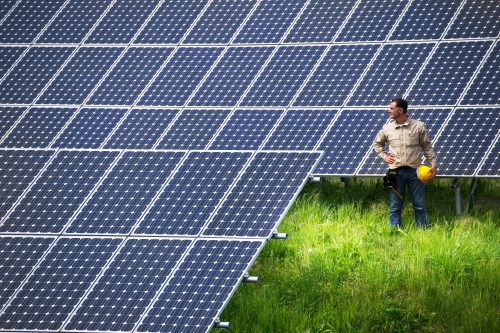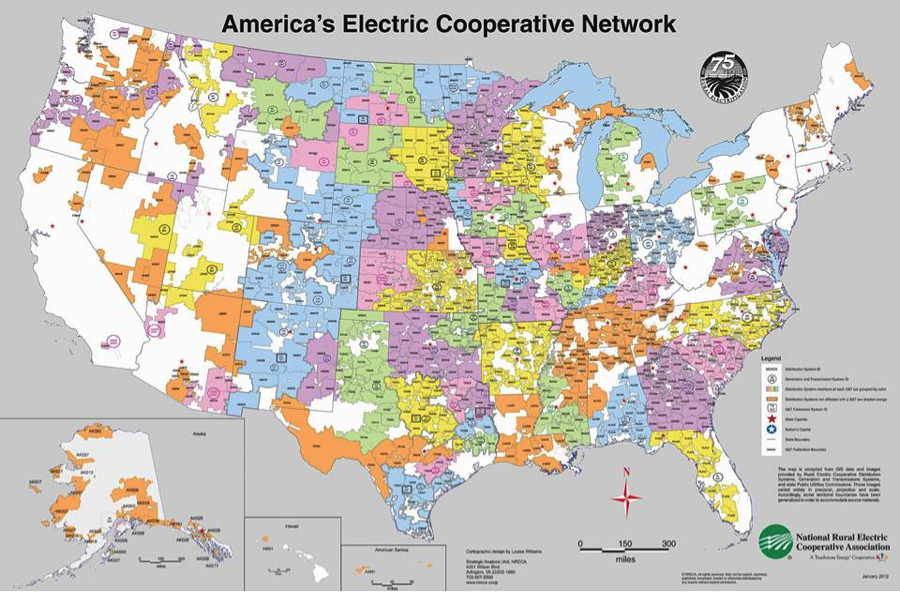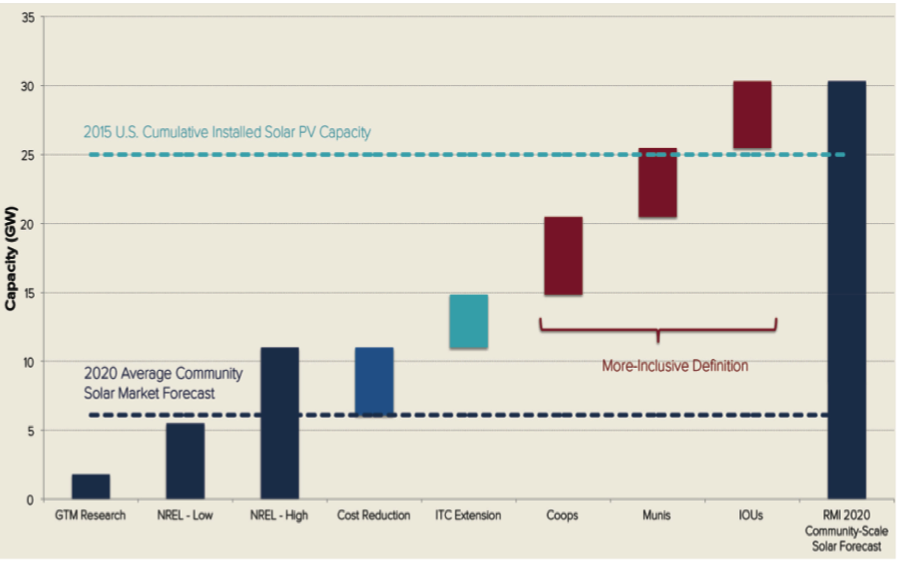
Why Rural Electric Cooperatives Are Opting for Community-Scale Solar
Rural electric cooperatives (co-ops) are a large and important part of the U.S. electricity landscape. Across the U.S., 840 distribution cooperatives and 65 generation and transmission cooperatives (G&Ts) serve an estimated 42 million people. Altogether co-ops provide 12 percent of the nation’s electricity and serve nearly 80 percent of U.S. counties. These co-ops are governed by 7 cooperative principles. Principle number 6 is cooperation among cooperatives. That means that when one co-op has a successful idea they spread the word and other co-ops opt-in.
Source: National Rural Electric Cooperative Association
The successful idea of the moment is community-scale solar. Rural electric cooperatives are spreading the word on how local clean power can save money, support communities, and diversify energy supplies. Community-scale solar is becoming an important tool for rural electric cooperatives as they begin their transition from a centralized fossil-fuel-based energy system to an increasingly distributed and renewable system.
WHY CO-OPS LIKE RENEWABLES
Though traditionally co-ops have been highly coal-dependent they are increasingly turning towards wind and solar for several reasons:
- Economics: From 2005 to 2015, solar PV system prices fell nearly 70 percent. The levelized cost of electricity from solar is now competitive with non-renewable energy. Given recent price declines, renewables can save co-ops money.
- Portfolio diversification: Renewable electricity can protect co-ops against volatile energy prices.
- Regulation: Co-ops are trying to stay ahead of mandates and regulation like RPS standards and the EPA’s Clean Power Plan.
- Member demand: Co-ops are owned by their members and responsive to member needs. Members are calling for economic development and environmental benefits through local clean power and co-ops are listening.
Co-ops take a variety of approaches to renewable power. Some G&Ts are signing contracts with utility-scale wind and solar projects. However, an increasingly popular option among distribution co-ops and G&Ts is to purchase power from community-scale solar sources.
WHY CO-OPS LIKE COMMUNITY-SCALE SOLAR
Community-scale solar refers to mid-size (i.e., 0.5–5 MW), distribution-grid-connected solar PV. It includes shared solar (i.e., subscribers to solar gardens) as well as small utility-scale systems with G&T or distribution co-op off-takers. It can be owned by the co-op or contracted through a power purchase agreement (PPA).
For many co-ops, community-scale solar is at the sweet spot between utility-scale and behind-the-meter solar. It simultaneously leverages the economies of scale of utility-scale solar with the many distributed benefits of behind-the-meter solar.
Benefits of Solar PV by Scale
Source: RMI Insight Brief
Community-scale solar is at a sweet spot for any utility, but some of its attributes make it particularly appealing to co-ops, particularly distribution co-ops. These attributes include:
- Local control: “Autonomy and independence” is enshrined in co-op DNA as one of the seven cooperative principles. Though many distribution co-ops are constrained by long-term contracts to purchase energy from a G&T, most have the ability to self-generate 5 percent or more of their energy needs. Co-ops can increase their autonomy and independence through local control of community-scale solar.
- Appropriate size: The median distribution co-op serves 13,000 customers, corresponding to 296 GWh of energy consumption and 33 MW average demand. This means that few distribution co-ops are large enough to contract for utility-scale solar. But even smaller distribution co-ops have adequate demand to incorporate community-scale solar PV. Furthermore, although few co-op-controlled distribution substations have adequate capacity to integrate utility-scale generation, many substations are large enough to accommodate community-scale installations.
- Community benefits: Concern for community is the seventh cooperative principle. Community-scale solar can provide multiple community benefits including increased local tax revenue and local jobs.
- Decreased energy losses: Co-ops serve an average of 7.4 consumers per mile of line, compared to 34 customers per mile for IOUs. Transmission and distribution energy line losses—partly a function of the length of wires—waste 6 percent of U.S. electricity. Energy losses will be highest in utilities with extensive distribution systems like distribution cooperatives. Since community-scale solar can be located close to loads on the distribution grid, it can effectively provide multiple distributed energy benefits including reduced line losses.
WHY MORE CO-OPS HAVEN’T ALREADY GONE SOLAR
It’s relevant to ask yourself—If community-scale solar is the sweet spot for co-ops, then why has co-op solar build out been relatively slow?
We believe that for the co-op community-scale market to rapidly expand co-ops need to access compelling community-scale offerings and must better understand the value of community-scale solar.
1. Co-ops need to access compelling community-scale offerings
Community-scale prices become compelling when multiple distributed power blocks are aggregated into portfolios. According to Craig Harmes of Dairyland Power, a Wisconsin G&T, “Dairyland Power’s experience with our recent request for proposals was that there was not a significant price difference for a portfolio of small utility-scale projects compared to one large utility-scale project.”
Only a few distribution cooperatives are large enough to procure their own community-scale solar portfolios. Most rural electric cooperatives are small and can most effectively access low prices by aggregating demand with neighboring co-ops. There are several models for aggregating demand, some led by G&Ts, and some driven by the distribution co-ops.
Shine is working with co-ops to identify, implement, and scale community-scale aggregation models. Earlier this month, Shine issued an open request for proposals that aggregates demand for community-scale solar from two rural electric cooperatives in Northern New Mexico. Shine expects to scale its efforts with rural electric cooperatives, enabling hundreds of megawatts within two years. Later this week, Shine will publish a follow-up blog profiling how three rural electric cooperatives are developing innovative community-scale solar portfolios.
2. Co-ops need to better understand the value of community-scale solar
Many co-op decision makers have misconceptions about the costs and benefits of solar. Often co-ops are familiar with solar cost data that may be a few years old. Given the dramatic price declines in the solar market, even data that is six months old may not capture the cost-competitive nature of solar.
Even if a co-op is convinced of the value of solar and is interested in developing a program, staff may not know how to best execute the solar procurement process. Most distribution co-ops rely on their G&T providers for power purchases. Consequently many co-ops have limited experience contracting with independent power producers in general, and solar developers in particular.
Shine works with distribution co-ops and generation and transmission providers to understand and access the value of community-scale solar. RMI is supporting co-ops with scoping, procurement execution, vendor selection, and PPA execution. Many co-ops with limited staff are unable to dedicate significant staff time to solar procurement. RMI is able to provide industry knowledge and a non-biased perspective to support co-ops on their way to solar procurement.
WHAT’S NEXT FOR THE CO-OP SOLAR MARKET?
Once compelling offerings exist and co-ops demand those offerings, the co-op community-scale solar market is poised to explode. How big will the co-op market get?
Distribution co-ops frequently sign all-inclusive contracts with their generation and transmission providers. These contracts generally allow distribution co-ops to self-generate up to 5 percent of their energy needs. If all distribution co-ops self-generate 5 percent of their energy with community-scale solar, the co-op community-scale market would be 10 GW.
We believe that if co-ops and G&T providers work together on community-scale solar they could generate 2.5 percent of co-op electricity demand from community-scale solar by 2020, corresponding to an installed base of 5–6 GW.
Community-Scale Solar 2020 Market Potential Scenario
Source: RMI Insight Brief
The market will need to grow rapidly to hit 5 GW by 2020, but more and more co-ops will jump on board when they see their peers building successful projects. Co-ops know each other and share information, so good ideas have a tendency to spread—fast.
In a future blog post we will elaborate on the setups and critical success factors of three successful co-op community-scale solar models in Wisconsin, Texas, and New Mexico.
To learn more about Shine’s work with Rural Electric Cooperatives email kbrehm@rmi.org.
Top image courtesy of Alan Levine Creative Commons license (CC BY-NC-ND 2.0).


